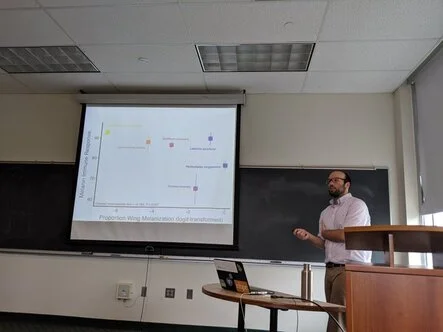
News
Medley lab co-sponsors LEC postdoc, Mike Moore
Mike Moore, PhD, has begun a 2-year position as a Living Earth Collaborative postdoctoral fellow
Mike Moore, PhD, has begun a 2-year position as a Living Earth Collaborative postdoctoral fellow with the Medley lab and the lab of Kasey Fowler-Finn at Saint Louis University. Mike is part of the first cohort of LEC fellows, a program aimed at stimulating collaboration among LEC partner institutions.
See Mike’s website here.
Katie's buckets are famous!
It’s rare that scientists see the good in the presence of an invasive species. But Washington University in St. Louis researchers discovered that a native mosquito in Missouri has fewer parasites when it shares its water with an interloper.
New research from Washington University in St. Louis shows that larvae of the invasive Asian rockpool mosquito (pictured above) consume parasites that might otherwise infect the native eastern tree-hole mosquito. (Photo: Eileen Kumpf/Shutterstock)
May 15, 2019
A tale of two skeeters
Tyson Research Center biologists discover something positive about an invasive mosquito species
By Talia Ogliore
It’s rare that scientists see the good in the presence of an invasive species. But Washington University in St. Louis researchers discovered that a native mosquito in Missouri has fewer parasites when it shares its water with an interloper.
Scratching your head? Yes, mosquitoes have parasites. And yes, being parasitized is costly for an organism, no matter how much humans love to hate that organism.
“The extra energy put into fighting an infection, or lost to consumption by a parasite, can lead to changes in behavior in the host. That can change its ability to escape predation or compete for space and resources,” said Katie M. Westby, postdoctoral research associate at Tyson Research Center and first author of a new study published in the Journal of Animal Ecology. “Thus, if an invasive species reduces parasitism in a species in a community, it may indirectly affect other members of the community.”
Working at Tyson Research Center, the environmental field station for Washington University, researchers compared the parasite loads of members of the local eastern tree-hole mosquito species (Aedes triseriatus) with members of an invasive Asian rockpool mosquito species (Aedes japonicus), which has only been spotted in Missouri since 2005.
Both are what is called container-breeding mosquitoes, meaning that their eggs and larvae are commonly found in water-holding containers such as tires and buckets.
For this field experiment, researchers set up a mosquito nursery with 40 buckets of rainwater with varying levels of leaf debris. Three times a week, they sieved through some of the buckets of muck to remove the larvae of the invasive species that hatched. They left the others alone.
Researchers set up a mosquito nursery in these buckets so they could determine how the presence of an invasive species impacts the parasite load of the native species. (Photo: Kim Medley/Tyson Research Center)
In the water, mosquito larvae encounter a kind of parasite called a gregarine parasite when the larvae are filter-feeding. But this parasite is species specific, which means that if it gets vacuumed up by the wrong kind of mosquito larvae, it can’t complete its life cycle. And apparently that’s exactly what’s happening.
“We found the presence of the invasive rockpool mosquito significantly reduced parasite prevalence in the native tree-hole mosquito via a dilution effect,” said Westby, who dissected the mosquito larvae to look for the parasites in their midguts.
Gregarine parasites (Photo: Beth Biro/Tyson Research Center)
When the native mosquitoes were sharing space with invasives, the natives were infected with parasites 13% to 27% of the time; when the natives were kept alone, they had parasites 72% to 90% of the time.
It’s called “encounter reduction.” Quite simply, if the invasive eats the parasite first, the native never runs into it.
Biologist Kim Medley, director of Tyson Research Center who also leads the center’s mosquito research, noted: “Understanding the patterns and processes that manifest in infectious disease is fundamentally an ecological question – that is, it’s about species interacting with one another and with their environment.
“In this case, invasion reduced infection by reducing encounters with parasites, but not by altering the abundance of the native species; rather, the mechanism was through removal of infectious particles from the habitat,” she added.
“Studies like ours can broadly inform how infectious disease manifests and how it changes with changes in biodiversity. This concept can be applied to numerous systems, including infectious disease in humans,” Medley said.
Katie M. Westby Brenden M. Sweetman Thomas R. Van Horn Elizabeth G. Biro Kim A. Medley. “Invasive species reduces parasite prevalence and neutralizes negative environmental effects on parasitism in a native mosquito.” J Anim Ecol. 2019 May 7, 10.1111/1365-2656.13004
Thomas's paper was accepted for publication!
Thomas VanHorn, former Tyson high school TERFer and WashU undergraduate fellow research in our lab, will have his independent research project published* in an upcoming issue of the Journal of Medical Entomology.
Thomas VanHorn, former Tyson high school TERFer and WashU undergraduate fellow research in our lab, will have his independent research project published* in an upcoming issue of the Journal of Medical Entomology. Thomas's work, mentored by Tyson staff scientist Solny Adalsteinsson, led our team into the ForestGEO plot at Tyson to collect roughly 3,000 ticks during summer 2015. The results showed that high tick abundances were found in valleys and and on north or northwest facing slopes. Interestingly, but not surprisingly, nymphal (immature) ticks were less abundant where temperature variance was high.
Why is this important? Because the Lone Star tick is a vector for several important pathogens that cause human and wildlife disease, and being able to predict where abundance is highest without having to collect complex ecological data could be very useful for land managers who want to reduce the risk of tick encounters by humans and wildlife.
Thomas is currently a senior at WashU, and will head off to medical school next fall. What a great way to wrap up his undergraduate career and many summers at Tyson! Congrats Thomas!
*co-authors include: Thomas VanHorn, Solny Adalsteinsson, Katie Westby, Marko Spasojevic, Maranda Walton, Beth Biro, Jonathan Myers, and Kim Medley
Story in Entomology Today
Solny gives seminar at the National Great Rivers Research and Education Center
Solny presented some of her work from the Tyson prescribed fire experiment at the National Great Rivers Research and Education Center yesterday.
Solny presented some of her work from the Tyson prescribed fire experiment at the National Great Rivers Research and Education Center yesterday. She did a great job creating an overall story of what we're beginning to understand about tick population dynamics, behavior, bird-tick burden, and deer usage. And kudos to the undergraduate and high school fellows that contributed to the work: Hanna Peterman, Leslie Sterling, Aaron Heisey, Lexie Beckermann, and Delilah Sayer. Great job team!
Field season 2017 is...
...a wrap.
...a wrap. We had a great group of fellows (undergraduate and high school) conducting research on our team this summer. Lexie, Leslie, Hanna, Aaron, and Delilah all completed independent research projects, in addition to collecting data on our broader projects. Among other things, we completed our second season of tick collections in burned and unburned forest plots and wrapped up season one of our urban-rural albopictus project. We found some interesting preliminary results on the albopictus project that we included in our NSF proposal. Stay tuned...
Solny accepts new position at Tyson
Solny has recently accepted a new role at Tyson as our Staff Scientist.
Solny has recently accepted a new role at Tyson as our Staff Scientist. In addition to conducting research in her area of expertise, Solny will be developing new long-term research and developing new ways to contribute to national and international data networks (among a host of other duties). Congrats Solny!
New postdoctoral associate
Solny Adalsteinsson has accepted the post-doc position in our lab and will be joining us in July 2016.
Solny Adalsteinsson has accepted the postdoc position in our lab and will be joining us in July 2016. Solny is finishing up her PhD at the University of Delaware, where she examined the cascading impacts of invasive species and forest fragmentation on interactions among hosts, vectors, and pathogens. Welcome Solny!
Seeking postdoctoral associate
The Medley Lab is searching for post-doc in disease or vector ecology.
The Medley Lab is searching for postdoc in disease or vector ecology. Full posting below:
postdoctoral research associate position is available in the research group of Dr. Kim Medley at Tyson Research Center, Washington University in St. Louis. The candidate will have the opportunity to develop a research program in collaboration with current members of the lab group examining the ecology of vectors of wildlife and/or human disease. In addition, the candidate will be encouraged to develop and teach a course in their area of expertise to complement current courses at Washington University and Tyson Research Center. Candidates with strong quantitative skills and/or expertise in parasitology, disease ecology, mathematical modeling, geospatial analysis, or molecular tools are preferred.
The successful candidate will be based at Washington University's Tyson Research Center (TRC), an 800-ha field station located 20 miles from the main campus. TRC boasts a rapidly growing research infrastructure, including a 25-ha forest-dynamics plot that is part of a global network of plots coordinated through the Smithsonian Center for Tropical Forest Science and Global Earth Observatory (CTFS-ForestGEO), a new ~4000 ft2 laboratory facility, a newly constructed research garden, and opportunities for experimental and observational studies in forest, glade, prairie, and aquatic habitats.
The successful candidate will join a growing and interactive community of ecologists and evolutionary biologists at Washington University, TRC, and the St. Louis Ecology, Evolution and Conservation consortium of local partner institutions (http://www.sleec.weebly.com). In addition to developing a collaborative research program, candidates should have an expressed interest in mentoring undergraduate and high school research fellows at TRC, and being an active and contributing member of a dynamic field station.
Funding for salary is available for one year with the possibility of extension. Review of applications will begin March 14, 2016 and will continue until the position is filled. However, candidates are encouraged to e-mail Kim Medley (kim.medley@wustl.edu) to indicate interest in the position as soon as possible. The start date is flexible, but ideally the candidate will start summer 2016. To apply, please combine into a single PDF file your CV, a one-page statement of research interests focusing on potential projects that would complement existing research in the Medley lab (medleylab.weebly.com), and the names and contact information of three references. Application materials must be submitted electronically through https://jobs.wustl.edu by entering the job ID number 32760 as a keyword under “Basic Job Search.”















